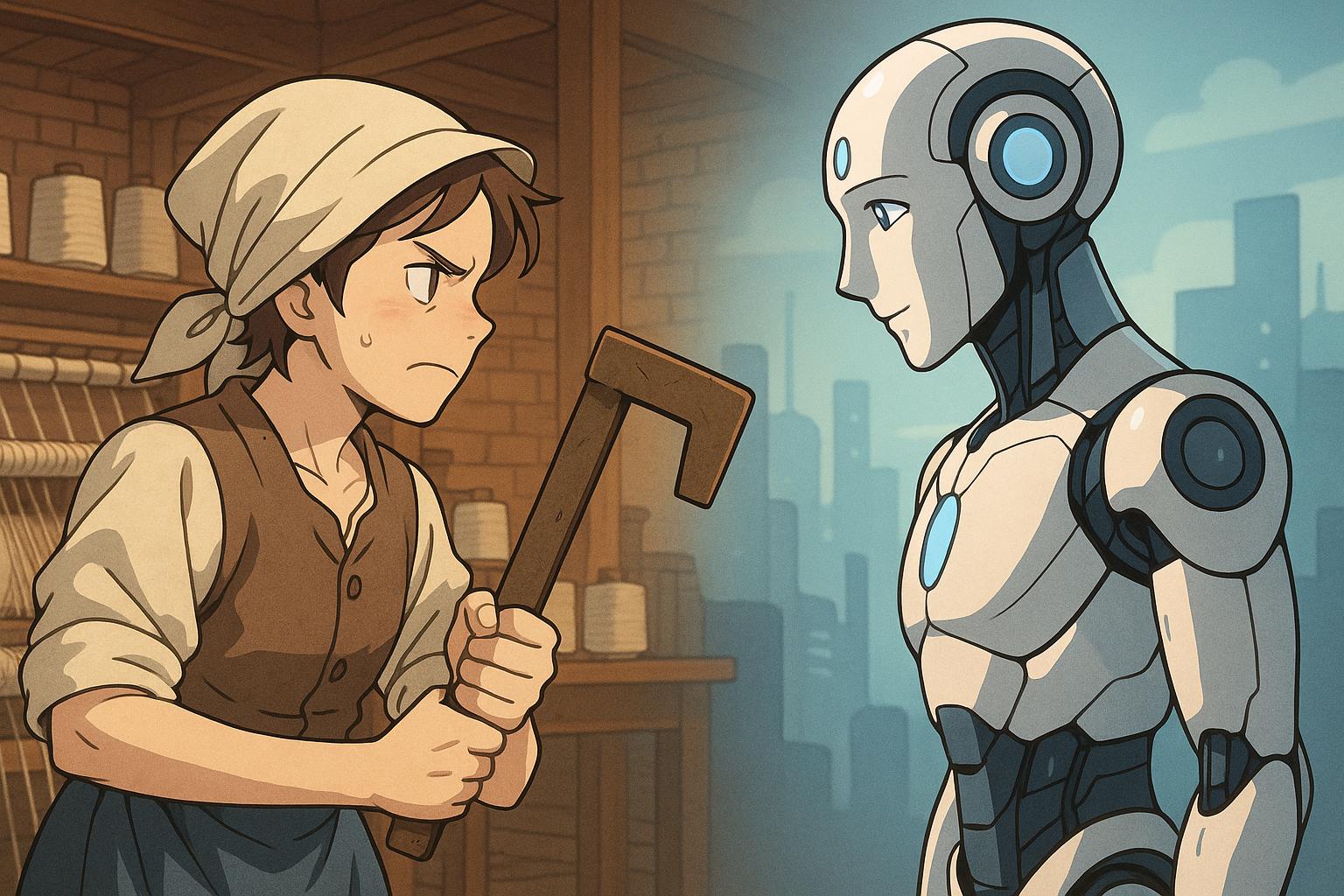Reflecting on the 19th-century Luddites’ resistance to unregulated technology reveals valuable lessons for today’s AI revolution: balancing progress with protections can foster innovation that uplifts workers rather than displaces them.
Back in the early 19th century, a group of skilled textile workers in England, known as Luddites, faced the harsh reality of technological disruption. Machines were encroaching upon their livelihoods, threatening the craftsmanship they had honed over many years. The Luddites were not inherently opposed to progress; they found themselves challenged by the irresponsible deployment of new technologies without the protections necessary for workers. Their resistance was a call for balance, advocating for an innovation landscape that served all societal members instead of marginalising skilled artisans.
Today, this historical narrative resonates strongly as we grapple with the rapid advancement of artificial intelligence (AI). The shift towards AI is reshaping various industries, instilling a sense of fear for many who see these technologies as potential job-stealers. However, much like the machines that once unsettled the Luddites, AI can also be viewed as a tool for enhancement rather than displacement. It presents opportunities for workers to augment their creativity, tackle intricate problems, and achieve greater efficiencies.
The evolution of technology has consistently spurred innovation in the human sphere, as illustrated by the past impact of the fax machine. During its rise in the late 20th century, many predicted the demise of courier services like FedEx, which appeared an anachronism in the face of instant document transmission. Contrary to these fears, the advent of the fax machine pushed FedEx to diversify and expand its offerings. Today, the company not only survives but thrives in a competitive landscape, demonstrating that technological advancements can catalyse growth rather than signal extinction.
Yet, the Luddite perspective rightly prompts deeper reflection on who benefits from such innovations and who is left behind in the process. The apprehension felt by smaller courier businesses serves as a reminder that disruption often creates winners and losers. Similarly, the rise of automated teller machines (ATMs) in the 1980s initially incited fears among bank tellers who predicted they would be rendered obsolete. Instead, ATMs reshaped the role of tellers, who transitioned to providing more complex customer services. This history illustrates that while technology can indeed alter job landscapes, it can also generate new roles that elevate human interaction and creativity.
Today’s portrayal of Luddites often depicts them as curmudgeonly figures opposed to all progress. However, their historical context highlights valid concerns regarding the unchecked advancement of technology. As AI becomes increasingly influential, it becomes crucial for advocates of the technology to acknowledge the fears it invokes and address the socio-economic challenges that arise from it. Transparency and empathy are essential in building trust within the public sphere.
Moreover, proactive strategies must be implemented to ensure that the transition to AI includes provisions for worker retraining, labour protections, and ethical guidelines that promote equity. Integrating the concerns of those wary of technology is vital; indeed, history demonstrates that when industries shift, new opportunities emerge that often require the uniquely human attributes of creativity, empathy, and intuition.
AI presents a dual-edged sword: while it excels at processing data and automating repetitive tasks, it cannot replicate the core human qualities that drive innovation. The advent of AI technology is also fostering new fields such as AI ethics and human-centered design, suggesting that innovation can lead to benefits beyond mere job displacement.
As we navigate the complexities of this technological age, it is essential to heed the Luddite caution that progress must be just. The responsibility lies with society to shape technological advancements that uplift humanity as a whole rather than privileging a select few. Embracing AI should not equate to fear or disdain for humanity’s creative capabilities; instead, it can act as a springboard towards unprecedented possibilities.
As Jay Rosser aptly points out, our potential to innovate and adapt is vast. If history has taught us anything, it is that we need not fear the tools we build, for there is no AI without the human “I.”
 Reference Map:
Reference Map:
- Paragraph 1 – [1], [2], [4]
- Paragraph 2 – [1], [5], [6]
- Paragraph 3 – [3], [5], [6]
- Paragraph 4 – [4], [7]
- Paragraph 5 – [1], [4], [3]
Source: Noah Wire Services
- https://www.dallasnews.com/opinion/commentary/2025/06/07/a-luddites-view-of-ai/ – Please view link – unable to able to access data
- https://www.dallasnews.com/opinion/commentary/2025/06/07/a-luddites-view-of-ai/ – In this article, Jay Rosser draws parallels between the 19th-century Luddite movement and contemporary concerns about artificial intelligence (AI). He discusses how Luddites opposed technological advancements that threatened their livelihoods and craftsmanship, advocating for innovation that benefits workers. Rosser suggests that AI, like past technologies, can enhance human creativity and expertise, urging a balanced approach to technological progress that considers both innovation and worker welfare.
- https://www.scientificamerican.com/podcast/episode/what-the-luddites-can-teach-us-about-ai/ – This podcast episode explores the historical context of the Luddite movement and its relevance to today’s discussions on artificial intelligence. It highlights that Luddites were not inherently anti-technology but opposed the exploitation of workers through mechanisation. The conversation draws parallels between past and present, emphasising the need for responsible and ethical deployment of AI to prevent similar exploitation.
- https://www.bbc.com/news/business-34813903 – This BBC News article examines the Luddite movement’s historical context and its relevance to modern technological advancements. It discusses how Luddites opposed mechanisation that threatened their livelihoods and craftsmanship, drawing parallels to contemporary concerns about AI and automation. The article suggests that while technology can displace workers, it can also lead to new job creation and economic growth, highlighting the need for balanced progress.
- https://www.theguardian.com/commentisfree/article/2024/jul/27/harm-ai-artificial-intelligence-backlash-human-labour – In this opinion piece, Ed Newton-Rex discusses the growing backlash against AI and its impact on human labour. He draws parallels between the current anti-AI sentiment and the historical Luddite movement, highlighting concerns about job displacement and the devaluation of human skills. The article calls for a more thoughtful approach to AI integration, considering its effects on workers and society.
- https://www.imf.org/en/Publications/fandd/issues/2025/03/a-place-for-human-talent-in-the-ai-age-marina-tavares – This article from the International Monetary Fund discusses the implications of AI on human creativity and employment. It highlights concerns that over-reliance on AI could stifle innovation and lead to job losses. The piece advocates for a balanced approach, suggesting that AI should complement human abilities rather than replace them, and calls for policies that support workers in adapting to technological changes.
- https://www.axios.com/newsletters/axios-ai-plus-cf521d18-654d-46a2-b138-7f6a9ce36c92 – This Axios newsletter discusses the rapid adoption of AI in various industries and the potential for significant job displacement. It highlights concerns that AI could eliminate up to 50% of entry-level white-collar jobs in the next five years, leading to increased unemployment. The article calls for careful consideration of the social and economic impacts of AI and advocates for policies that balance innovation with worker protection.













